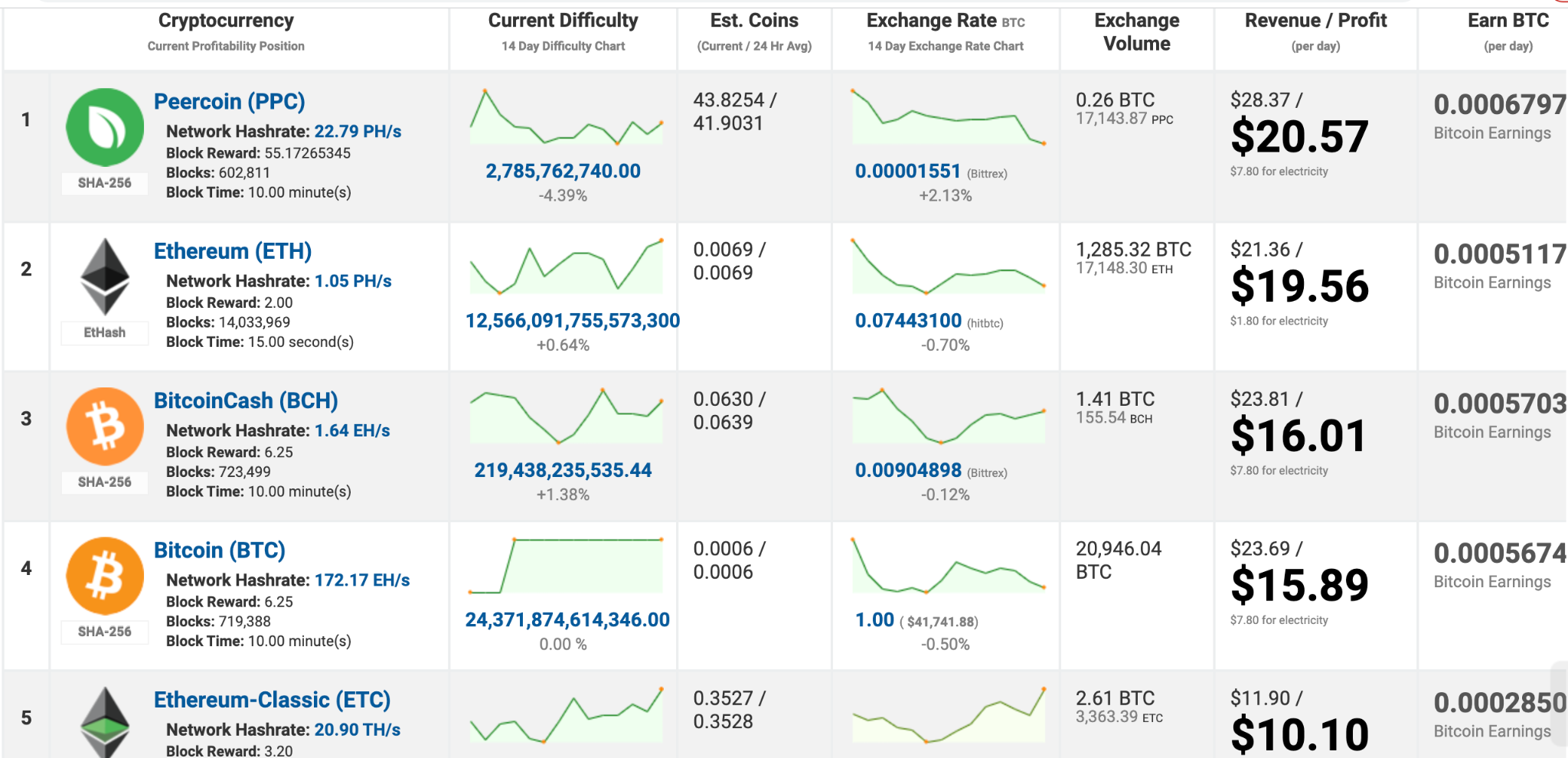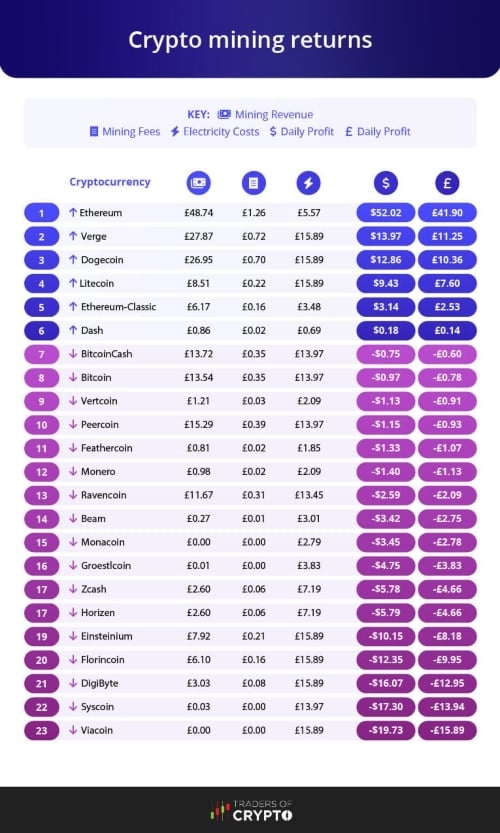The most profitable cryptocurrencies to mine are Bitcoin and Ethereum. They offer high returns due to their strong market positions.
Cryptocurrency mining involves validating transactions on a blockchain network, earning rewards in the form of digital coins. Bitcoin and Ethereum stand out as the most lucrative options for miners. Bitcoin remains dominant due to its high value and widespread adoption.
Ethereum’s shift to proof-of-stake has reduced mining rewards, but it still offers profitability. Miners should consider hardware costs, electricity expenses, and market trends. Efficient mining operations, utilizing powerful GPUs or ASICs, can maximize returns. Staying updated with market dynamics ensures continued profitability in this competitive field.
Introduction To Cryptocurrency Mining
Cryptocurrency mining is a popular way to earn digital coins. It involves solving complex mathematical puzzles. Successful miners earn rewards in the form of cryptocurrency. This process is vital for the security and functionality of blockchain networks.
What Is Mining?
Mining is the process of validating transactions on a blockchain. Miners use powerful computers to solve difficult puzzles. These puzzles ensure the authenticity of each transaction. Once solved, the transaction is added to the blockchain.
This process also helps to create new coins. It’s like a digital mint that produces new currency. Mining is crucial for maintaining the integrity of the blockchain.
Why Mine Cryptocurrencies?
Mining cryptocurrencies can be highly profitable. Successful miners earn rewards in the form of new coins. These rewards can be very valuable. Many miners also enjoy the process of solving puzzles.
Mining also helps to secure the network. By validating transactions, miners ensure that the blockchain remains secure. This is essential for the trust and reliability of the network.
Additionally, mining can be a good investment. The value of mined coins can increase over time. This makes mining an attractive option for many people.
Factors Influencing Profitability
Mining cryptocurrencies can be profitable. Three main factors influence profitability: hardware costs, electricity rates, and mining difficulty. Each factor plays a key role in determining your potential earnings.
Hardware Costs
Hardware costs can vary greatly. Miners need powerful hardware to mine effectively.
ASIC miners are popular but expensive. Graphics cards (GPUs) are also used for mining.
| Type | Cost Range |
|---|---|
| ASIC Miner | $500 – $10,000 |
| GPU | $300 – $1,500 |
Electricity Rates
Electricity rates impact mining costs. Lower rates mean higher profits.
Miners should know their local electricity rates. Rates vary by location and provider.
- Low rates: $0.05 per kWh
- Average rates: $0.10 per kWh
- High rates: $0.20 per kWh
Mining Difficulty
Mining difficulty affects how hard it is to mine a cryptocurrency. Higher difficulty means more competition.
Difficulty adjusts based on network activity. Higher difficulty can lower profits.
- Check difficulty levels regularly
- Choose coins with manageable difficulty
- Adapt mining strategies as needed
Top Profitable Cryptocurrencies
Mining cryptocurrencies can be very profitable. Let’s explore the top profitable cryptocurrencies to mine. Each one has its own benefits. These options are popular among miners.
Bitcoin
Bitcoin is the first and most valuable cryptocurrency. It uses a proof-of-work algorithm called SHA-256. Many miners prefer Bitcoin because of its high value. You need specialized hardware, called ASICs, to mine Bitcoin efficiently.
Here is a quick overview:
| Algorithm | Hardware Required | Profitability |
|---|---|---|
| SHA-256 | ASICs | High |
Ethereum
Ethereum is another popular choice for miners. It uses the Ethash algorithm. Unlike Bitcoin, you can mine Ethereum with GPUs. Ethereum is known for its smart contract capabilities. This makes it a valuable asset.
Key details:
- Algorithm: Ethash
- Hardware Required: GPUs
- Profitability: Medium to High
Litecoin
Litecoin offers faster transaction times compared to Bitcoin. It uses the Scrypt algorithm. This makes it easier to mine with consumer-grade hardware. Litecoin is often referred to as the silver to Bitcoin’s gold.
Here are its main features:
- Algorithm: Scrypt
- Hardware Required: GPUs or ASICs
- Profitability: Medium
Mining Bitcoin
Mining Bitcoin is a popular way to earn cryptocurrency. It involves solving complex mathematical problems. When solved, miners receive Bitcoin as a reward. This process helps maintain the Bitcoin network.
Required Equipment
To mine Bitcoin, you need specific equipment. Here’s a list of what you need:
- ASIC Miner: This is a special device for mining Bitcoin. It is faster than regular computers.
- Power Supply: ASIC miners use a lot of electricity. A strong power supply is essential.
- Cooling System: Mining generates a lot of heat. Proper cooling is needed to keep the equipment safe.
- Bitcoin Wallet: You need a wallet to store the Bitcoin you earn.
- Mining Software: This software connects your equipment to the Bitcoin network.
Expected Returns
Your returns depend on several factors. These factors include:
| Factor | Impact |
|---|---|
| Hash Rate | Higher hash rates increase your chances of earning Bitcoin. |
| Electricity Costs | Lower electricity costs mean more profit. |
| Bitcoin Price | Higher Bitcoin prices lead to higher returns. |
| Network Difficulty | Higher difficulty levels make mining harder and less profitable. |
Here is a simple example:
- Your ASIC miner has a hash rate of 100 TH/s.
- Your electricity cost is $0.10 per kWh.
- The current Bitcoin price is $50,000.
- You mine 0.005 Bitcoin per month.
In this example, your monthly earnings would be 0.005 Bitcoin. This equals $250. Subtract your electricity cost to find your profit.
Mining Ethereum
Ethereum is one of the most profitable cryptocurrencies to mine. It offers a robust ecosystem and widespread adoption. Ethereum mining can be done using different types of hardware. Let’s dive into the details of GPU and ASIC mining, and analyze their profitability.
Gpu Vs. Asic Mining
Ethereum mining can be performed using two main types of hardware: GPUs and ASICs.
GPU Mining
GPUs, or Graphics Processing Units, are versatile and widely available. They are generally used in gaming computers. GPUs can mine various cryptocurrencies, not just Ethereum. This makes them a flexible option for miners.
Popular GPUs for Ethereum mining include:
- NVIDIA GeForce RTX 3080
- AMD Radeon RX 6800 XT
- NVIDIA GeForce RTX 3060 Ti
ASIC Mining
ASICs, or Application-Specific Integrated Circuits, are specialized hardware. They are designed specifically for mining certain cryptocurrencies. ASICs offer higher efficiency and performance compared to GPUs. However, they can only mine specific algorithms.
Popular ASICs for Ethereum mining include:
- Antminer E9
- Innosilicon A10 Pro+
- Bitmain Antminer S19
Profitability Analysis
Mining profitability depends on several factors. These include hardware costs, electricity costs, and the current price of Ethereum.
| Type | Initial Cost | Hash Rate | Electricity Consumption | Monthly Profit |
|---|---|---|---|---|
| GPU (NVIDIA RTX 3080) | $700 | 90 MH/s | 220W | $200 |
| ASIC (Antminer E9) | $10,000 | 3,000 MH/s | 2,700W | $4,500 |
From the table, ASICs provide higher monthly profits. However, they have a higher initial cost. GPUs have lower initial costs and offer more flexibility. Electricity costs also significantly impact profitability. Always calculate your electricity rates before investing in mining hardware.

Mining Litecoin
Litecoin (LTC) has gained popularity among cryptocurrency miners. It offers a profitable and efficient mining experience. Compared to Bitcoin, Litecoin has faster block generation. This results in quicker transaction times. Litecoin uses the Scrypt algorithm. This makes it accessible for miners with less powerful hardware.
Scrypt Algorithm
The Scrypt algorithm plays a significant role in Litecoin mining. It is less complex than Bitcoin’s SHA-256. This makes it easier for miners with basic equipment. Scrypt is designed to be memory-intensive. This reduces the advantage of specialized ASIC miners. Thus, it levels the playing field for individual miners. Here is a quick comparison:
| Algorithm | Complexity | Hardware Requirement |
|---|---|---|
| Scrypt | Lower | Basic |
| SHA-256 | Higher | Advanced |
Cost Efficiency
Mining Litecoin offers good cost efficiency. The Scrypt algorithm requires less electricity. This makes mining more affordable. Miners can use basic hardware, reducing initial investment. Here are some key points:
- Lower electricity costs
- Affordable hardware
- Reduced initial investment
Cost efficiency makes Litecoin a popular choice for miners. It provides a balance between profitability and expenses. Many miners find Litecoin mining sustainable in the long term. This contributes to its widespread adoption.
Alternative Cryptocurrencies
With the popularity of Bitcoin, many miners seek alternative cryptocurrencies. These alternatives often offer better profitability and unique benefits. Let’s explore some profitable alternative cryptocurrencies.
Monero
Monero (XMR) is known for its strong privacy features. It uses advanced cryptography to hide transaction details. This makes Monero a popular choice for those valuing anonymity.
- Algorithm: RandomX
- Block Reward: 2.15 XMR
- Hardware: CPU
Monero’s RandomX algorithm is designed to be ASIC-resistant. This means it can be mined using standard CPUs. This makes it accessible for home miners.
Zcash
Zcash (ZEC) focuses on privacy and selective transparency of transactions. Users can choose to hide or reveal transaction details.
- Algorithm: Equihash
- Block Reward: 3.125 ZEC
- Hardware: GPU
Equihash, the algorithm used by Zcash, is optimized for GPU mining. This provides a fairer distribution of mining rewards.
Ravencoin
Ravencoin (RVN) is a blockchain designed for the efficient transfer of assets. It is a fork of Bitcoin and has several enhancements.
- Algorithm: KAWPOW
- Block Reward: 5,000 RVN
- Hardware: GPU
The KAWPOW algorithm is ASIC-resistant and favors GPU mining. Ravencoin’s high block reward makes it attractive to miners.
| Cryptocurrency | Algorithm | Block Reward | Hardware |
|---|---|---|---|
| Monero | RandomX | 2.15 XMR | CPU |
| Zcash | Equihash | 3.125 ZEC | GPU |
| Ravencoin | KAWPOW | 5,000 RVN | GPU |
Maximizing Mining Earnings
To maximize your mining earnings, you need to make smart decisions. These decisions include choosing the right mining pool and maintaining your hardware. Let’s dive into the details below.
Choosing The Right Pool
Choosing the right mining pool is crucial for higher earnings. Here are some tips:
- Pool Size: Larger pools offer more consistent rewards.
- Fees: Look for pools with lower fees.
- Payout Frequency: Check how often the pool pays out.
Below is a table comparing some popular pools:
| Pool | Fees | Payout Frequency |
|---|---|---|
| Pool A | 1% | Daily |
| Pool B | 2% | Weekly |
| Pool C | 1.5% | Bi-Weekly |
Regular Hardware Maintenance
Maintaining your hardware regularly can increase your earnings. Follow these steps:
- Clean your hardware: Dust can reduce performance. Clean it monthly.
- Update software: Keep your mining software updated.
- Check temperatures: Overheating can damage hardware. Use cooling systems.
Here are some tools for hardware maintenance:
- Compressed Air: For cleaning dust.
- Thermal Paste: For better cooling.
- Monitoring Software: To keep track of temperatures.
Future Of Cryptocurrency Mining
The future of cryptocurrency mining is bright and full of promise. With advancements in technology, mining is becoming more efficient. The landscape is continually evolving, bringing new opportunities and challenges.
Upcoming Trends
Several trends are shaping the future of cryptocurrency mining. Green mining is gaining traction, focusing on using renewable energy. This method reduces the carbon footprint.
Another trend is cloud mining. It allows users to mine cryptocurrencies without buying expensive hardware. This makes mining accessible to more people.
The rise of ASIC-resistant coins is also notable. These coins are designed to be mined with general-purpose hardware. This ensures a more decentralized network.
Potential Challenges
While the future looks promising, there are challenges. Regulation is a major concern. Governments are creating laws that affect mining operations.
Another challenge is the high energy consumption of mining. It can lead to increased costs and environmental concerns. Miners need to find ways to reduce energy use.
Network difficulties also pose a challenge. As more miners join, the competition increases. This can make it harder to earn rewards.
Despite these challenges, the potential for profit remains high. By staying informed and adapting to changes, miners can succeed.


Frequently Asked Questions
Which Crypto Is Best To Mine?
Ethereum is popular due to its profitability and community support. Monero offers privacy and is CPU-friendly. Bitcoin requires significant resources.
What Is The Most Profitable Crypto Mining Device?
The most profitable crypto mining device is the Bitmain Antminer S19 Pro. It offers high efficiency and profitability.
What Crypto Is Worth Mining In 2024?
Ethereum, Bitcoin, and Monero are worth mining in 2024. They offer good profitability and strong community support.
Which Crypto Mining Software Is Most Profitable?
The most profitable crypto mining software varies, but popular options include NiceHash, CGMiner, and BFGMiner. Profitability depends on factors like hardware, electricity costs, and current market conditions. Always research and compare before choosing.
Conclusion
Mining cryptocurrencies can be highly profitable with the right choices. Focus on coins with lower difficulty and higher rewards. Stay updated with market trends and technological advancements. Invest in efficient mining hardware to maximize returns. By carefully selecting the most profitable cryptocurrencies, you can enhance your mining success and financial gains.


